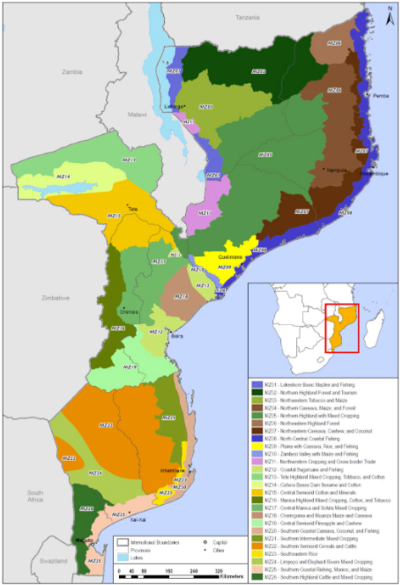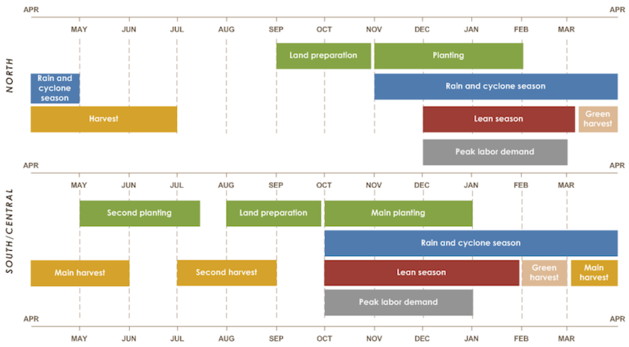Agriculture Sector in Mozambique
Introduction
Mozambique is an agricultural country with over 70 % of the population dependent on agriculture for their livelihood in 2019[1]. Agriculture is also the second largest contributor to the national GDP after the service industry. In 2019, it accounted for 24% of the GDP[2]. In general, there has been a decline in agricultural labour force from 82% in 2000 to 70% in 2019 but the percentage is still significantly high[1] The agricultural sector is also gendered with women accounting for the majority of the labour force. In 2019, the sector employed 80% of female labour force[1].
Climate and Soil Pattern
Mozambique has ten agro-ecological zones (AEZs) which are based on topography, rainfall and soil criteria. The classification was done by the National Institute of Agronomic Research (INIA) and is shown in figure 1[3].

Table: Agroecological Zones in Mozambique[4]
| Zone | Soil type | Rainfall (mm/year)* |
| Zone R1: Semi-arid interior south | Sandy | 570 |
| Zone R2: Semi-arid coastal south | Deep sand | 500-600 |
| Zone R3: Arid interior south | Loamy-clay | 400-600 |
| Zone R4: Mid-elevation central | Clay | 1000-1200 |
| Zone R5: Coastal central | Vertisol and fluvisol | 1000-1400 |
| Zone R6: Dry semi-arid Zambezia and Tete | Sandy-clay | 500-800 |
| Zone R7: Interior central and north | Sandy-clay | 1000-1400 |
| Zone R8: Coastal north | Mostly sand and clay (small scale) | 800-1200 |
| Zone R9: Interior north of Cabo Delgado | Lime and sand | 1000-1200 |
| Zone R10: High altitude | Hard ferralsol | >1200 |
Mozambique is also divided into 26 livelihood zones (geographical areas of a country where people share similar food and income options as well as have similar access to markets)[3] . For details about each livelihood zone, main crops grown and access to markets please refer to this publication: Mozambique Livelihood Zone Descriptions. Figure 2 shows the different livelihood zones.

Zone 1: Lakeshore Basic Staples and Fishing
Zone 2: Northern Highland Forest and Tourism
Zone 3: Northwestern Tobacco and Maize
Zone 4: Northern Cassava, Maize and Forest
Zone 5: Northern Highland and Mixed Cropping
Zone 6: Northern Highland Forest
Zone 7: Northeastern Cassava, Cashew and Cononut
Zone 8: North-central Coastal Fishing
Zone 9: Plains with Cassava, Rice, and Fishing
Zone 10: Zambezi Valley with Maize and Fishing
Zone 11: Northwestern Cropping and Cross-Border Trade
Zone 12: Coastal Sugarcane and Fishing
Zone 13: Tete Highland Mixed Cropping , Tobacco and Cotton
Zone 14: Cahora Bassa Dam Seame and Cotton
Zone 15: Central Semiarid Cotton and Minerals
Zone 16: Manica Highland Mixed Cropping, Cotton and Tobacco
Zone 17: Central Manica and Sofala Mixed Cropping
Zone 18: Cheringoma and Muanza Maize and Cassva
Zone 19: Semiarid Pineapple and Cashew
Zone 20: Southern Coastal Cassava, Coconut and Fishing
Zone 21: Southern Intermediate Mixed Cropping
Zone 22: Southern Semiarid Cereals and Cattle
Zone 23: Southearn Rice
Zone 24: Limpopo and Elephant Rivers Mixed Cropping
Zone 25: Southern Coastal Fishing, Cassava and Maize
Zone 26: Southern Highland Cattle and Mixed Cropping
In general, Mozambique has two distinct climate patten which affect the type and quantity of agricultural production. The northern and central region has tropical and sub-tropical climate while the southern region has arid and semi-arid climate[3]. Thus, the central region enjoys a two-plantation season due to higher precipitation while the southern region generally has single plantation season as shown in Figure 3.

In terms of soil, the northern and central province generally have fertile soil while the south has sandy soil. The Zambezi delta in particularly has high rich alluvial soils. In southern province, the river basins of Save, Limpopo, Incomáti, Umbelúzi, and Maputo do have small pockets of alluvial soils[7]. For details about the soil type in different AEZ, refer to Table 1 above.
Land Use
In 2018, agricultural land included 52.7% of the total land area but only 7.2% of the total land area is arable. The rest 47.3% of the land area is occupied by forest[8].
Breakdown of land use in 2018[8].
| Land area (sq km) | |
| Total land area | 786,380 |
| Agricultural land | 414,138 |
| Forest Land | 372,241,7 |
| Arable land | 56,500 |
Land Holdings
The Mozambican agricultural sector is dominated by 3.2 million smallholder farmers who produce 95% of the agricultural production[9]. On average, the farm size ranges from 1-2 hectors for smallholder farmers and are mostly concentrated in the Zambezi Province (central region)[3]. The smallholder farmers are categorised by low agricultural productivity and are mostly rainfed and subsistence farming. Thus, technologies such as solar powered irrigation have the potential to increase agricultural productivity and contribute to economic development as well as increase smallholder farmers resilience to climate change related disasters such as droughts.
There main crops grown by smallholder farmers are[10]:
- Staple food crops such as maize, cassava, rice and pigeon peas for mainly household consumption
- Cash crops such as cotton tobacco, oil seeds and tea.
- Tree crops such as cashew and coconut in mostly coast areas.
For a detailed overview of which crops is produced in which region, please refer to this publication.
Mozambique also has limited commercial farming with only around 400 commercial farmers in the country. They account for the remaining 5% of the agricultural production[9]. They grow export crops such as cotton, cashew nuts, sugarcane, tobacco and tea. The commercial farmers have access to irrigation and are mostly in the southern part of the country.[11]
Agricultural - Imports and Exports
The top six imported agricultural products in Mozambique in 2019 include: rice, wheat, palm oil, sugar and maize.[12]
The top six exported agricultural product in 2019 are cheroots, sugar, beans, bananas and tobacco.[12]
Land Laws and Policies
For a list of all policies, legislations and decrees related to land use, water use and agriculture in Mozambique, please refer to the FAO database.
This section outlines some of the important legislations:
Mozambique's Land Law (1997): All land in Mozambique is State-owned. Individuals, communities, corporate entities and foreigners have the right to use the land if they hold customary rights to the land; have been using the land for over ten years; or have a legal authorisation to use the land. The land tenure differs from one entity to another[13].
This law allows the use of land without formal documentation. The law was initially drafted to protect the rights of smallholder famers and at the same time increase private investment. However, in practice, the smallholder’s farmers are vulnerable and are not able to defend their land rights against private sector who have more resources.[14]
Resolução n. 42/2016 - Aprova a Política de Águas, em anexo, que é parte integrante da presente Resolução: This National Water Policy includes guidelines for water resource management and use in Mozambique as well as private sector participation.[15]
Resolution No. 60/98 establishing tariffs for water uses: This policy sets the tariffs for different water uses such as domestic use and irrigation. Water usage for domestic needs as well as for livestocks and small-scale irrigation (without any mechanical structure) is free.[15].
Further Reading
- Mozambique Off-grid Knowledge Hub
- Climate-Smart Agriculture in Mozambique: https://climateknowledgeportal.org/sites/default/files/2019-06/CSA-in-Mozambique.pdf
- FAO (2016): Country Profile – Mozambique: http://www.fao.org/3/i9805en/I9805EN.pdf
References
- ↑ 1.0 1.1 1.2 ‘Employment in Agriculture (% of Total Employment) (Modeled ILO Estimate) - Mozambique | Data’, accessed 27 May 2021, https://data.worldbank.org/indicator/SL.AGR.EMPL.ZS?locations=MZ.
- ↑ ‘Mozambique - GDP Distribution across Economic Sectors 2009-2019’, Statista, accessed 27 May 2021, https://www.statista.com/statistics/507266/mozambique-gdp-distribution-across-economic-sectors/.
- ↑ 3.0 3.1 3.2 3.3 CIAT and World Bank, ‘Climate-Smart Agriculture in Mozambique’, 2017, https://climateknowledgeportal.worldbank.org/sites/default/files/2019-06/CSA-in-Mozambique.pdf.
- ↑ 4.0 4.1 T Walker et al., ‘Priority Setting for Public-Sector Agricultural Research in Mozambique with the National Agricultural Survey Data’, 2006, https://ageconsearch.umn.edu/record/56113/files/rr_3E.pdf.
- ↑ FEWS NET, ‘Mozambique - Seasonal Calendar’, 2013, https://fews.net/southern-africa/mozambique/seasonal-calendar/december-2013.
- ↑ FEWS NET, ‘Mozambique - Seasonal Calendar’, 2013, https://fews.net/southern-africa/mozambique/seasonal-calendar/december-2013.
- ↑ ‘Mozambique - Drainage’, Encyclopedia Britannica, accessed 3 May 2021, https://www.britannica.com/place/Mozambique.
- ↑ 8.0 8.1 World Bank, ‘Agricultural Land (% of Land Area) - Mozambique’, accessed 1 June 2021, https://data.worldbank.org/indicator/AG.LND.IRIG.AG.ZS?locations=MZ.
- ↑ 9.0 9.1 ‘Mozambique at a Glance | FAO in Mozambique | Food and Agriculture Organization of the United Nations’, accessed 27 May 2021, http://www.fao.org/mozambique/fao-in-mozambique/mozambique-at-a-glance/en/.
- ↑ USAID, ‘Property Rights and Resource Governance Country Profile: Mozambique’, 2018, https://land-links.org/wp-content/uploads/2011/02/USAID-Land-Tenure-Mozambique-Profile-FINAL.pdf.
- ↑ FAO, ‘Country Profile - Mozambique’, 2016, http://www.fao.org/3/i9805en/I9805EN.pdf.
- ↑ 12.0 12.1 ‘FAOSTAT: Commodities by Country’, 2021, http://www.fao.org/faostat/en/#rankings/commodities_by_country_imports.
- ↑ Jurisafrica, ‘Translation_of_Land_Act_of_1997’, 1997, https://jurisafrica.org/docs/statutes/Translation_of_Land_Act_of_1997.pdf.
- ↑ LandLinks, ‘Mozambique’, LandLinks (blog), 2018, https://land-links.org/country-profile/mozambique/.
- ↑ 15.0 15.1 FAO, ‘FAOLEX Database - Mozambique’, 2021, http://www.fao.org/faolex/results/details/en/c/LEX-FAOC117331/#.



















